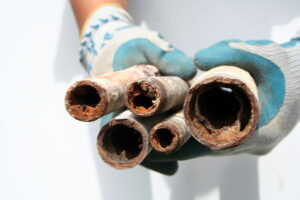If you’ve purchased a home rather than building one from the ground up yourself, there are a lot of things going on behind those walls and below those floorboards that you can’t possibly know about. And depending on what year your home was built, there could be materials that you really don’t want to be exposed to, particularly in your plumbing.
You may be surprised to hear some of this information about the changing materials used in home plumbing, but it’s always better to be informed. If there are outdated pipe materials in your home, there could be unpleasant consequences you don’t want to deal with. The solution is repiping.
Plumbing Materials: A Timeline
The first sanitation systems, made of tile and clay piping, were constructed in Mesopotamia around five thousand years ago. Copper pipes were being used by Egyptians around 4,500 years ago. And in Crete, the first-known rudimentary flushing toilet, made of stone, was created almost 4,000 years ago.
More recently, about 2,200 years ago, Romans began using lead piping. Some scholars speculate that the resulting health problems contributed to the downfall of Rome. (We need to point out that few reputable scholars agree with this; it’s a fringe position). And in France in 1664, a 15-mile water main was constructed of cast iron.
Shockingly, these same materials were in use in American homes very recently. Clay was used for sewer pipes, the lines that carry all the wastewater away from homes, until 1980. Cast iron and galvanized steel were modern alternatives to older materials, but their lifespan is only 40–50 years before they corrode or break.
While lead pipes were gradually phased out, it wasn’t until 1986 that they—and lead solder used to connect pipes of other materials—were banned. But wait! Fixtures could still contain lead. Finally, in 1998, all fixtures that were not “lead-free” were banned… but “lead-free” was defined as containing less than 8% lead.
Today’s Plumbing Materials
When a home is built today, the plumbing consists of copper—yes, the Egyptians got it right, thousands of years ago—and, for certain applications like tight spots and hot water lines, plastic. The two types of plastic considered safe and durable are PEX and CPVC. But if your home’s plumbing has been in place for decades, it could contain any of those other outdated materials.
All About Repiping
The benefits of having your home repiped are tremendous. First, there’s the obvious elimination of any health risk from the lead that was so commonly used. But you’ll also be eliminating the risk of corrosion and rupture of old pipes, which could cause massive water damage and plumbing emergencies, as well as slower leaks and costly wasted water.
While repiping is a big job, it can typically be completed in the span of just a few days. When you’re ready to plan for home repiping in Suwanee, GA, our team is ready to help you navigate the process and get your home safe, healthy, and ready to last many more decades.
To speak with a member of our team, contact DC Cheek Heating, Cooling & Plumbing today. Fixed, At the Speed of Life!




